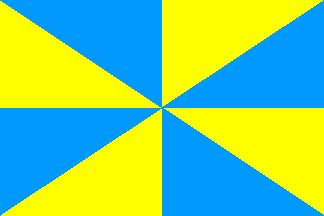
Last modified: 2006-09-30 by antónio martins
Keywords: almada | coat of arms | castle (golden) | cross: saint james (red) | quinas: 2 (16 plates) | quina: 16 plates | wave |
Links: FOTW homepage |
search |
disclaimer and copyright |
write us |
mirrors

The flag is a gyronny of light blue over yellow
with arms in the centre. The arms has a 5-towered
mural crown, a typical scroll reading "CIDADE DE ALMADA"
and a blue shield, charged by a yellow castle over a black hill and three wavy
lines silver-blue-silver. The castle has three towers, the central one is charged
with a Santiago cross, and the lateral towers are charged
with old portuguese "quinas", each with 16 bezants
in a pattern of 4-3-4-3-2.
Jorge Candeias, 07 Jun 1998
As for the symbolism, the river is quite obvious and the cross refers
to the first portuguese sttlers of this region, the Santiago Order. Castles are
probabbly the most often motive on portuguese municipal arms — there was a castle in
Almada, but there’s nothing left of it for centuries. (There are other more recent
fortresses in the municipality, but I dont think the arms refers to them.) As for the
rest, well, Old Almada is up on a small hill (but it is not at all black, but
rather yellowish); and the quinas are also a common motive, usually
atibuted to municipalities (or communes) with some regal background.
António Martins, 16 Jun 1998

Almada is a city located in front of Lisbon, across the Tejo estuary. It is
a typical dormitory-city, largely populated by people that work in Lisbon.
It’s economy is, therefore, very dependent of Lisbon, and is largely made
up of services, though there are in the municipality some industries and
touristic resources. The municipality belongs to the
district of Setúbal, old province of
Estremadura and possibly will belong to the region of
Lisboa-e-Setúbal.
It’s a small municipality (70 km2.), but heavily
populated (over 152 000 inhabitants in 11 communes) and has coast both in
the estuary and in the ocean. Here, there is a small protected natural area.
Jorge Candeias, 07 Jun 1998
Anything below this line was not added by the editor of this page.